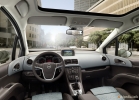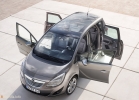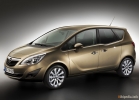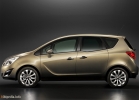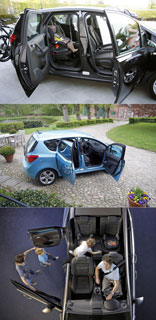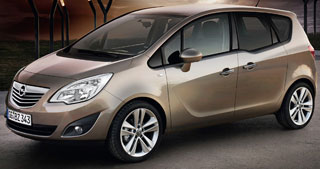Test Drive Opel Meriva since 2010 Minivan
Love and business plan
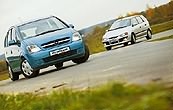 The single-vocabulary or half-and-half-section body layout has always been attractive for designers and developers. Over the past decade, almost every manufacturer included at least one similar model in its model range, and the volume of minivan production is growing from year to year. If you extrapolate this tendency for the future, it will come out that all the passenger cars will turn into one-uniforms. Now the process has reached the second phase, systematization and trails are time to share their own classes. Let's look at the smallest sizes excellent to us well-known Mitsubishi Space Star and only appearing in the Opel Meriva market. Naturally, taking into account the difference in age.
The single-vocabulary or half-and-half-section body layout has always been attractive for designers and developers. Over the past decade, almost every manufacturer included at least one similar model in its model range, and the volume of minivan production is growing from year to year. If you extrapolate this tendency for the future, it will come out that all the passenger cars will turn into one-uniforms. Now the process has reached the second phase, systematization and trails are time to share their own classes. Let's look at the smallest sizes excellent to us well-known Mitsubishi Space Star and only appearing in the Opel Meriva market. Naturally, taking into account the difference in age. General
As a rule, one-novels are not specifically developed, but are built on the platform of a sedan already existing in the production range or at least laid together with a whole family of bodybuons. Initially, it was understood that the minivans would have either three rows of seats or a giant luggage compartment (if without seats). The main idea was built on the same area as the base machine, a high bus, with a more vertical landing of the rides and shifted forward by layout. But gradually looks at the subject expanded, not only the models of C and D segments became the basis for extension, but also very tiny dimensions of V. Pravda, in relation to our experimental it is not quite accurately Space Star is made of short-circuit Carisma, and Meriva essence Corsa with Added elements from Astra! Here is such a cocktail. Mitsubishi has the following engines: 1.3 l 82 liters. p., 1.6 l 98 liters. with. and 1.8 l 112 liters. p., And Opel has such: 1.6 l 87 and 100 liters. with. and 1.8 125 liters. with. It is quite logical to compare modifications with an average power. Otherwise, external sizes, weight category and dynamic characteristics of cars are also almost identical, which allows them to consider them direct competitors.
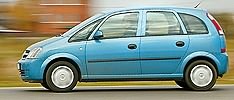 Dynamics
Dynamics Is it possible to demand close or at least comparable parameters and characteristics from two cars, one of which meriva with mechanics, and the other spaces are old with a machine gun? So it turned out to live cars now not too much and you have to take what they give. But I suggest not too worry about this, because for a single application, these differences go to the background, pondering the criteria of practicality. How to find out what car is more? Dry numbers in the table will not replace the sensations obtained empirically. You can come to the dealer at least where it is, and the Baro voice will require dating from the car not in the cabin, but on the road. You will probably offer to ride a company with a manager who should follow so that you do not leave the commencement and did not borrows, although the insured, but state property. So it will not be able to drive knowingly. Our possibilities are somewhat wider, although I still would not want to abuse freedom, and, like some colleagues, to drive absolutely peaceful, civil versions in the proven regimes, washing the tires to the slicks and we are sorrowfully due to the lack of speed of standard rearrangement. Of course, the car with a handle starts sharper, although it becomes very clear that the competitor ceases to lagging behind and even begins to make sure the missed one. But in the range of high revolutions on each transmission and, naturally, with fast mechanical switches, Opel is playing the meter per meter, although to a lesser extent than it could be assumed on the basis of the difference between the two types of transmission. It should be added that the switching of the Japanese AKP is soft and short, but somewhat blurred, with a slight slip effect. The illusion of speed of overclocking Meriva also creates a sonorous accompaniment that occurs after 3500 revolutions and after 130 km / h, regardless of transmission. But the noise of the motor and the resonance of the wheeled arches is not always a sign of active acceleration! Against this background, silence in the space star simply amazes apparently, before it was not yet so sought to save the weight in weight, and did not regret extra kilograms ten on noise insulation. The braking dynamics of both cars frankly pleases, both in the degree of slowdown and the informativeness of the pedal. But if a German car freezes almost in the stand at the counter, Mitsubishi at the end of the braking is noticeably peeling his nose. And this happens even with a partial slowdown.
Controllability
With handling the picture is the following. Meriva rulits almost like a passenger car. In comparison with the corsa rolls and the swings did not add. And it is even strange, because the increase in the center of gravity due to the general rosy and the highly located long and heavy steel roof inevitably leads to an increase in the moments of inertia relative to the longitudinal and transverse axes. Space Star somehow falls under this pattern, although it would not be risked by Valka. Is that in a duel with the Opel, you begin to notice that in a sharp turn of Mitsubishi slightly rolls over the external front wheel, as if a little gladly laying the knee. From the point of view of passing irregularities, it is not so easy to identify better. The Japanese is definitely a more energy-intensive suspension, but it works somewhat specifically. If you remember the tests of the carism, then all who are not too lazy, noted harsh blows when the elastic elements are working on the back. Space Star inherited the same style: Everything is going on the average pits, but you will start jumping out from the borders or cheerfully slip through large irregularities to hear the characteristic ringing blows of straightening springs. Just their lengths are not enough to stretch significantly more than with static load.
Patency is by no means an estimated category for purely urban cars, but who prevents at least take her into account? Do not forget that, except for normal streets, there is a sufficient number of areas where at least occasionally forced to travel each of us. And given the increased trunk volume in comparison with the basic model with a folded second number of seats, it is not difficult to assume that the periodic trips to the phasende with a refrigerator-dresser are almost guaranteed. And here is the unconditional favorite Space Star. Its high ground clearance and flat bottom helps to quickly storm and borders, and moderate settlements. And it is not important here, but the real height of the thresholds is them, and not the lowest point of the crankcase pallet or the beam of the leading bridge most likely, you risks to make a footpath. True, Mitsubishi has low skes so that go-to call better by macason. But Opel, on the contrary, the body almost drags on asphalt, but there are almost no soles!
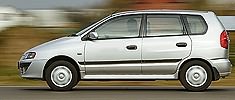 Ergonomics
Ergonomics There are few competitors are comparable to them from different eras and even from different centuries. Mitsubishi was created at the time when the company did not think about the total update of the model range, which began in the past season. Inside the not too obsolete body hides a very archaic stuffing design. The interior is overloaded with an abundance of curvilinear, chubby fragments. In addition, everything is performed in the gloomy, but the black-ranging black color, which is visually stealing space. However, the evidence of all functions and simplicity of management is accurate. Of the disadvantages, one family arrangement of the middle rear head restraint in the review zone is corrected in two seconds by dismantling interference. Another minus is also incomplete. We are talking about a stealless turn signal switch. He sticks out at a significant angle up and sometimes disorientates the driver: then suddenly it seems that the right turn is not turned off, and that truly without canceling the command to the left, you believe that the switch is in a neutral position. And ticks the turn signal on this machine completely quiet. Memiva on this background looks almost flawlessly laconicism, which goes into a ascetic, is very suitable for modern, compact and utilitarian. Gray plastic with implanted and read-reading CD-magnetic and climate control does not require much time for adjustments. And the information is perfectly perceived from the screen located on the original cylinder, raised above the instrument panel. From the Opolev inconvenience, notes the lack of handrail under natural grip on the trimming of the doors. Pull the door when you slam it, not a problem and behind the horizontal pen, but the passenger while driving is not for that, except for the handrail on the ceiling. But for a long time, it is inconvenient to go. Ergonomics of a driver's seat None of the microflows do not cause complaints, although it is surprised by the armrest on Space Star. It is insufficient length to make a hand in there, but I would interfere with me when switching (we have a machine!). Compact machines with a large area of \u200b\u200bglazing, by definition, should not have blind areas overview. This is especially helped by a stand-forward rack, not overlapping moving in the transverse direction of the machine. But on Mitsubishi, the front side glass is solid, and on the Opel, by virtue of the design of the doorway, an additional rack occurs and the triangle of the window.
Practicality
Obviously, practicality as a category should dominate cars with a similar type of layout. Therefore, it is worth noting that both the other manufacturers tried to fame a second row of seats easily cleaned down, forming one-piece volume. In Meriv, in addition, the back of the driver's seat is formed forward for the length of the long periods. Also here is the floor, and the decoration of the luggage compartment is more practical. But if the sofa does not fold, then ride in the second row passengers is spacious in Mitsubishi. But you can get around the windows in front. Single Acquisites have short bumps, and Opel opens a narrow slit through which only the valve cover is visible. But Space Star suggests heating, if necessary, in the motor with the same success as on the sedan, the hood cover of normal length.
Summary
If the material is easier to see that I see, I sing, then draw conclusions and the estimates are always risky. The dynamics are important, and another fuel economy, someone wants to be placed behind the wheel, and someone is important that the hired driver transports that loads, then passengers ... do this time, conclusions yourself, and I only hint . Mitsubishi Space Star My old love, but time is coming. Opel Meriva on his background looks more interesting, especially if you acquire this car in private property. But for business, I would still take Mitsubishi. Yes, he is a little cheaper.
HOW DO THEY LOOK
Nikita Rozanov
Outside: five years of age difference The term for modern automotive design is very significant ... According to the laws of world market conditions, during this time it is required to carry out if not a cardinal change of style, then at least facelifting. Designers and developers Mitsubishi Some of the pioneers of the expansion of Japanese minivans to Europe did everything correctly: Space Star was presented in the 98th, and in the new century, the car spent a facelift. Opel Meriva Product 2003 The car is young, and the plastic surgery is not required by it. Take a look at the face: Meriva The same vectra, only small and very large. This is the so-called corporate design, very fashionable today. Space Star, alas, in this nomination loses. The appearance of the machine does not correlate with the style that offers for Mitsubishi its current main designer Olivier Boule. In the profile, Opel's leadership is even more obvious, and its brave silhouette with four side windows and short, turning in the rack A, the bike is just a spirit of time. At first glance, and behind the leader is the same. But take a look, as elegantly solved the form of the rear lighting of Minivan: Space Star True Japanese and Master Details.
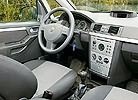 Inside: If you feel behind the wheel, the effect of the meeting of the two centuries is even stronger. High-tekki style Opel, who loved by many of the same Vectra, is undoubtedly modern and sharpering that Japanese designers offer. This also applies to the steering wheel, which is on Space Star only four-spin, and on Meriva is concise and sports, and the overall plastic design of the Opel interior, which is resolved is sharper and more dynamic. And this is still the main stylist sign of our time.
Inside: If you feel behind the wheel, the effect of the meeting of the two centuries is even stronger. High-tekki style Opel, who loved by many of the same Vectra, is undoubtedly modern and sharpering that Japanese designers offer. This also applies to the steering wheel, which is on Space Star only four-spin, and on Meriva is concise and sports, and the overall plastic design of the Opel interior, which is resolved is sharper and more dynamic. And this is still the main stylist sign of our time. SUMMARY: Well, of course, as in most cases (but not always), younger wins and the design of Opel designers. Although items ... See how they are executed on a Japanese car: more traditionally, but somehow clearer, and although all this is less stylish, but more suitably more convenient.
Text Vladimir Smirnov photo Alexander Nozdrin
A source: Cars
Video Test Drives Opel Meriva since 2010
Video crash tests Opel Meriva since 2010
Test drives Opel Meriva since 2010
Crash Test Opel Meriva since 2010
Crash Test: Details89%
Driver and passengers
55%
Pedestrians
77%
Children-passengers
86%
Active security system

